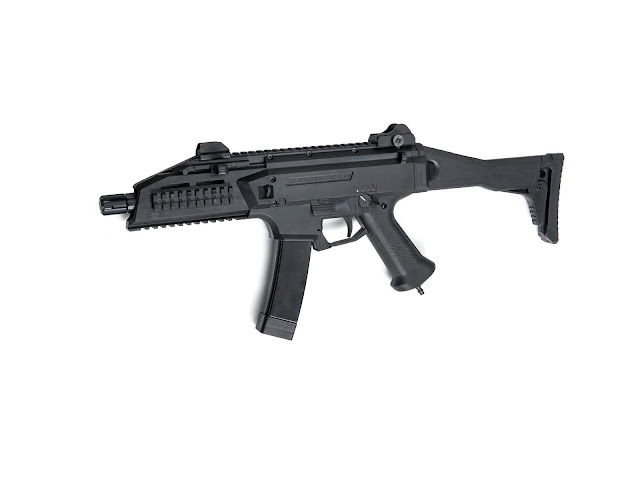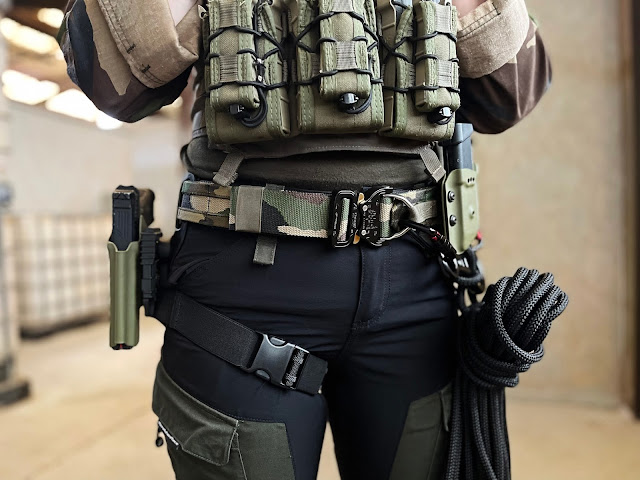Hey friends!
Welcome back to another blog post in the 'Airsoft 101' series! In this post, we'll be taking a look at 'what is HPA?' In airsoft, there are 4 main power sources that power airsoft replicas, and they are: spring, electric, Gas/C02 and HPA (or High-Pressure Air). We didn't explore HPA in the 'Beginners Guide to Airsoft Guns' as they're a little more complex. So, without further adieu, let's get into it!
So HPA or High-Pressure Air airsoft replicas are airsoft guns that are powered by pressurised air that is held in an external canister - this air is fed to the weapon via a regulator and line. Pressurised air enables HPA guns to have faster rates of fire, be quieter, and have a higher FPS than electric and gas airsoft guns, making HPA guns a great choice for anyone who wants to airsoft competitively.
In an HPA gun, the pressurised air is delivered to the gun with every trigger pull rather than relying on a mechanical process to create pressurised air within the gun itself (like with AEGs). However, there are examples of pneumatic systems that are fully mechanical, made for players that want a more realistic trigger and firing feel but this still relies upon an external source for air pressure. It is worth noting that AEGs can be converted to HPA - and this involves gutting the AEG of all its internals and installing an HPA engine.
The external canister is often called a ‘Tank’, this is what holds the highly pressurised air and is refillable. This is filled up using a dive tank and can be done at any diving shop or airsoft site that offers HPA filling facilities. The Dominator 48/3000 HPA Aluminium Airsoft Tank from Extreme Airsoft is a great example.
On the stem of the tank, you'll need to use a regulator, like this Balystic HPR800C V3 HPA regulator and this is used to release the air into the line. You adjust the pressure using an Allen key. It also tells you how much air is in the tank. The line is then what feeds the air into the airsoft gun.
There are even packages like this HPA Package inc. Tank, Reg and Line that make it super easy. Please note, these cannot be used with an AEG, they have to be used with a HPA airsoft gun.
Now that we have explored just what is HPA airsoft, let’s go through the pros and cons of HPA airsoft guns. Whilst they are enticing, the pros and cons should be fully considered before investing in an HPA setup.
Let’s look at the Pros of HPA Guns:
HPA replicas offer totally adjustable FPS with no disassembly required! The FPS of an HPA airsoft gun is raised and lowered by controlling the air pressure's PSI. The PSI can be adjusted on the regulator without any need to disassemble the gun. It also offers a high FPS. The higher PSI the higher the FPS will be. Remember, no matter how high your FPS can physically go, you can only shoot as high as the site limit, which for most sites in the UK is 350 FPS.
Faster Rate of Fire - As well as offering players a higher FPS, the power in an HPA airsoft gun provides a faster rate of fire.
Consistent FPS - HPA airsoft guns offer the user undeniable consistency between shots, and this is because the gun allows the same volume of air into the expansion chamber each time, meaning the same amount of air is used to push the BB out of the barrel every time.
Simple Internal Design - You know the old saying ‘less to go wrong? That applies to HPA systems, compared to Automatic Electric Guns, HPA airsoft guns don't have as many moving parts making them less likely to malfunction.
Quiet - The noises we hear from airsoft guns are the internal mechanisms working. In AEGs this includes pistons, gears etc and in gas guns, this includes the bolt carrier group but in HPA guns as they only use air pressure to propel the BB, the only noise we hear is that of the BB leaves the barrel.
But what about the cons?
Realism and looks - Whichever way you look at it, having a weighty tank and a line attached to your weapon removes some of the realism that airsofters want (not all airsofters but realism is one of the things that draw people into airsoft). The faster rates of fire and less noise also take away realism points.
Weight - A traditional HPA setup includes a tank, reg, and line. Whilst the tanks aren’t too heavy, they do add weight and bulk to your loadout and this should be considered. If you like to have the lightest/least intrusive loadout possible, a traditional HPA set-up may not be the most suitable for you. But there are companies in the airsoft sphere that are revolutionising HPA such as Wolverine Airsoft which has developed a tank that is held in the stock of a weapon.
Cost - It’s no secret that HPA set-ups are more costly than AEGs and GBBRs. This is because usually, you will need a gun that can be gutted of its internals to replace them with an HPA system, a tank, reg and line which all adds up. Ready-built HPA Airsoft guns such as the HPA Version of the AG Scorpion Evo also tend to be a little pricier on average.
Post sponsored by www.extremeairsoft.co.uk
















No comments